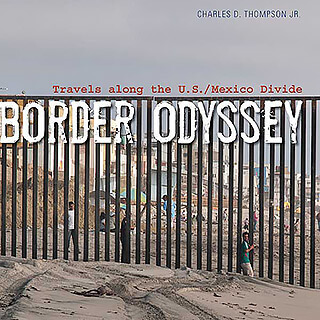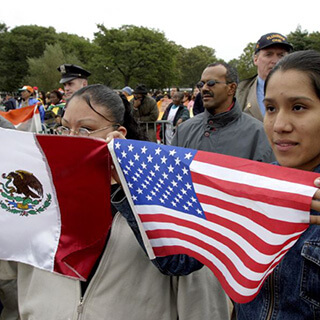Overview
Jamie Starling reviews Todd W. Wahlstrom's The Southern Exodus to Mexico: Migration across the Borderlands after the American Civil War (Lincoln: University of Nebraska Press, 2015).
Review


The defeat of the Confederacy, the prospect of military occupation and Republican state government, and the financial collapse of many plantations and businesses sent a number of white southerners in pursuit of life in a foreign land during the late 1860s. Between 1865 and the early 1870s approximately five thousand white and black southerners trekked to Mexico (28, 37).1Wahlstrom finds "a select number" of black southerners in Mexican settlements after the Civil War, and that the "dual movement of southerners" was "greatly skewed toward white migrants" (xxii, 26). A much larger contingent of African Americans, estimated at four thousand, had already arrived in northern Mexico by the Civil War years as fugitive slaves (41). Todd W. Wahlstrom examines this resettlement by studying colonies in the Texas border state of Coahuila. Much of The Southern Exodus to Mexico chronicles the rise and fall of ambitious colonization plans of such ex-Confederates as Matthew Fontaine Maury (scientist and naval officer from Virginia) and former Louisiana governor Henry Watkins Allen (12, 22). Wahlstrom revises earlier histories, engaging Andrew Rolle's The Lost Cause: The Confederate Exodus to Mexico (1965) that describes Confederate flight as "an attempt to snatch some sort of victory out of defeat"2Andrew Rolle, The Lost Cause: The Confederate Exodus to Mexico (Norman: University of Oklahoma Press, 1965), ix. and as an expression of delusional efforts to preserve Dixie in the Mexican highlands. Wahlstrom seeks to revise Rolle's contention that the southern exodus was a "failure" through revealing "the scope of the vision behind it" (xv). Although Rolle largely ignores the northern Mexican borderlands, Wahlstrom also emphasizes colonization in Coahuila, arguing that border states contributed to a "hemispheric south" where planters and railroad promoters envisioned business and trade networks across the Mexican borderlands and into Latin America during the last third of the nineteenth century (xxvii). Wahlstrom also considers the experiences of African Americans and non-slaveholding whites. Contra Rolle's account, southern emigrants to Mexico did not solely represent a "Lost Cause" flight of renegade whites, but a commercial vanguard. Economic interests yielded unlikely collaborations between Confederate exiles and Mexican liberals who returned to power in 1867 (85). Most of these commercial efforts involved agricultural enterprises, ranging from grand schemes for cotton plantations to the homesteads of black and white yeoman settlers who saw Mexico as an "agricultural paradise just waiting for southern migrants to build up its economy" (23).

Mexico might seem an unlikely destination for defeated Confederates, as its government formally abolished caste distinctions and chattel slavery after it gained independence in 1821. Additionally, Mexico had engaged in a war with pro-slavery Anglo settlers in Texas during the 1830s, and was still reeling from the effects of US invasion and occupation from 1846 to 1848. Nevertheless, a unique set of political circumstances made settlement appear promising in the summer of 1865. Under the imperial rule of Maximilian, the republican opposition forces of Benito Juárez were at low ebb, despite growing US pressure for France to decrease its presence in Mexico. Even after Mexico's loss of its northern territory to the US in 1848, vast areas remained beyond government control. Imperial forces, republican resistance, local strongmen, and indigenous peoples all contested Mexico's shifting borderlands.3See Pekka Hämäläinen, The Comanche Empire (New Haven, CT: Yale University Press, 2008).

Over three centuries after Álvar Núñez Cabeza de Vaca and Estevanico traversed the region, nineteenth-century Coahuila remained a "middle ground" between Apache, Comanche, and Kickapoo Indians, indigenous peoples who migrated into the area to either avoid white settlement or raid white settler outposts. Readers of James Brooks, Pekka Hämäläinen, and Brian DeLay will recognize the "network of violence, theft, and trade" that characterized Coahuila's society during much of the nineteenth century (63–68).4See James F. Brooks, Captives and Cousins: Slavery, Kinship, and Community in the Southwest Borderlands (Chapel Hill: University of North Carolina Press, 2002) and Brian DeLay, War of a Thousand Deserts: Indian Raids and the U.S.-Mexican War (New Haven, CT: Yale University Press, 2009). Wahlstrom does not go as far as these three historians in describing Indian nations as primary powers of this territory, as he finds their sway over Coahuila to be somewhat diminished by the 1860s (64–66). These indigenous groups figure primarily as vexatious raiders in The Southern Exodus to Mexico, not as existential threats to ex-Confederate settlements.
Confederate migration to Mexico is one point in a longer arc of Spanish and Mexican efforts to attract settlers to their northern borders in order to control the region. Andrés Reséndez documents the motives that led Mexican officials and, particularly, an ambitious northern Mexican commercial class to attract US settlement and trade during the first half of the nineteenth century.5Andrés Reséndez, Changing National Identities at the Frontier: Texas and New Mexico, 1800–1850 (New York: Cambridge University Press, 2005), 37.
Wahlstrom's research makes clear that the US-Mexico War did not diminish economic and settlement patterns. Instead, ex-Confederate migration mapped onto earlier patterns of migration from southern US states to the borderlands of Texas, New Mexico, and the adjacent areas of Tamaulipas, Nuevo León, Coahuila, and Chihuahua. There, white southerners from a slaveholding society found familiar class and labor dynamics. While Mexico was a multiracial nation that espoused the equality of all citizens before the law, it retained sharp divisions between Spanish-descended creoles, mestizos, and indigenous groups. Throughout the nineteenth century, Mexican liberals "argued that white immigration would bring economic advancement," modernization, and a whitening of the Mexican population (21). For their part, many white colonists brought a "racial exclusivity that only included elite Mexicans in the colonization plans." These transplants did not share the goal of transforming their host nation through assimilation or absorption (85).

For many African Americans who escaped slavery or the new forms of bondage that emerged after the Civil War, Mexico often represented freedom from racial oppression.6Quintard Taylor, In Search of the Racial Frontier: African Americans in the American West, 1528–1990 (New York: W.W. Norton, 1999), 41, 60. Sean Kelley, in a study of runaway slaves before the Civil War, vividly describes how Texan African Americans viewed Mexico as the land of liberty.7Sean Kelley, "Mexico in His Head": Slavery and the Texas-Mexico Border, 1810–1860," Journal of Social History 37, No. 3 (Spring 2004): 709–723. While employment by white colonists—often former slave owners—brought an unspecified number of black southerners to Mexico, Wahlstrom argues that their migration "corresponds with other forms of African American agency in the postwar period" (133). However, Wahlstrom also states that black southerners often relocated "under duress" with their former masters (39). In such instances, this agency involved escaping the oversight of former slave owners, as was the case of Thomas C. Hindman, an ex-Confederate general who witnessed the flight of former slave Charlie and the "defection" of other former slaves to Mexico (39). A desire to acquire land and earn economic independence attracted blacks to Coahuila, even though many white colonists envisioned for them only a subservient role on estates that recreated southern plantation life (46, 132, 133). At times, black southerners attempted to form their own colonies. Wahlstrom describes the efforts of William Ellis, whose short-lived 1894 colony in the Laguna area of Durango stands outside the temporal scope of his study but warrants consideration as an emblematic representation of both Mexico's potential and peril to blacks. The settlers experienced "exploitation" as agricultural workers as well as a "swath of yellow fever." Ultimately, when the settlement disbanded, the seventy remaining blacks left the Laguna colony to work in nearby mines. Wahlstrom simply asserts that "seventy of these colonists picked up their hopes and went to the mining town of Mapimí to continue their pursuit of freedom" (46). However, William Beezley's discussion of mining in northern Mexico during this period casts a stark shadow on these optimistic notes; miners endured grueling labor conditions in unlit, poorly ventilated shafts, working with simple hand tools and suffering from exposure to mercury and other toxic compounds.8William Beezley, Judas at the Jockey Club and Other Episodes of Porfirian Mexico, 2nd ed. (Lincoln: University of Nebraska Press, 2004), 74–76. Relocation to Mexico offered freedom from Jim Crow; nevertheless, opportunities for economic advancement were often limited for African American emigrants.

Wahlstrom's emphasis on leading colonizers such as Matthew Maury, and the political machinations between elite southerners and Mexican officials, obscures insights into the everyday experiences of black and white southern emigrants. While Mexico's leaders found "common ground" with former Confederates in their quest for white immigration, popular Mexican reactions to this influx of American settlers, aside from frequent references to "banditry," do not appear in The Southern Exodus to Mexico (21). An overall impression emerges that white southern colonists created isolated, self-contained enclaves characterized by a southern Protestantism in sharp relief to Mexican Catholicism (143). Wahlstrom's study affords little insight into the competing concerns over religion, language, legal procedure, intermarriage, and schooling that marked the settlement of other Mexican colonies. Aside from passing references to marriages and women and children held as captives, this history centers almost entirely on male settlers. Nancy Brigham, a widowed woman who settled with a group of Texans in the Córdoba colony of central Mexico, is one of the few women mentioned. Wahlstrom ventures that "her involvement reflects the appeal of Mexico as grounds for economic revival, a way to resuscitate her family's future" (24). Nevertheless, beyond ambitions for new farmland and speculative business prospects, Wahlstrom does not investigate how settlers attempted to recreate Dixie on the Mexican borderlands in cultural or spatial terms.

Instead, Wahlstrom traces US investment in Mexican railways, contending that economic interests were central to early efforts to link the two nations. He documents the competing efforts of former Union general William S. Rosecrans, who promoted a Mexico Pacific and Rio Bravo Railroad from New Orleans to Mazatlán, and Edward Lee Plumb, who planned to connect Laredo to San Blas on Mexico's Pacific Coast (115–117). As both proposals ultimately failed, Wahlstrom can only make limited claims about the "bilateral benefits of trade and economic development to Mexico and the South" (117). He nonetheless argues that these promoters "helped instill new pathways of prosperity and steer[ed] a course of transnational connections between the United States and Mexico during the second half of the nineteenth century" (127). Such glowing descriptions aside, the efforts of Confederate exiles in Mexico produced few tangible results in railroad and industry in the decade following the Civil War.
The final chapter of The Southern Exodus to Mexico makes a more convincing case that southern emigration to Mexico was a harbinger of a "New South" where white leaders embraced industry, finance, and commerce to progressively diversify an agrarian economy, while maintaining a conservative approach to labor and race relations (124–125). At a general level, Mexico's leaders shared these conservative tendencies (21). The transition from imperial rule to liberal governance made economic interests paramount in Mexico's immigration efforts. Several of the Mexican officials who brokered for southern colonists in the 1860s later worked to forge a borderlands economy through the promotion of railroads, mining, and commercial agriculture under Porfirio Díaz. Santiago Vidaurri, a regional strongman and ally of Díaz who exercised political and military dominance over Coahuila, facilitated these emerging trade connections (71–72).

Glorias de México!, with bust portrait of Porfirio Díaz, Mexico City, 1904. Broadside, on recto, by Antonio Vallegas Arroyo and José Guadalupe Posada. Courtesy of the Caroline and Ewan Swann Collection, Library of Congress Prints and Photographs Division, LC-DIG-ppmsc-04473.
Wahlstrom details how this particular migration period anticipates a coming era of US empire-building, where extensive commercial interests, especially in agriculture, created semi-colonial regimes in Mexico and Central America. Importantly, however, Confederate migration does not mark the beginning of US or imperial interest in Mexico. Juan Mora Torres, who also explores the emergence of a transnational economy in northeastern Mexico, dates the foundation of this "hemispheric" economy to the cotton trade that flourished before and during the Civil War.9Juan Mora Torres, The Making of the Mexican Border: The State, Capitalism, and Society in Nuevo León, 1848–1910 (Austin: University of Texas Press, 2001), 8. The Southern Exodus to Mexico makes a more convincing case that white southerners endeavored to promote cross-border business after the Civil War and that the increased publicity of Mexico's economic potential strengthened the case for foreign investment and more direct transportation linkages (111–112, 127). Ultimately, Wahlstrom provides few examples of lasting economic success or significant social transformations within these attempted southern colonies. 
About the Author
Jamie Starling is assistant professor of history at the University of Texas Rio Grande Valley. His research explores the United States Mexican Borderlands. His current project, "From the Moment I Made My Wedding Vows My Sorrow Began," focuses on domestic abuse and women's rights in the nineteenth-century Borderlands.
Recommended Resources
Text
Barr, Alwyn. Black Texans: A History of African Americans in Texas, 1528–1995. 2nd ed. Norman: University of Oklahoma Press, 1996.
Davis, Edwin Adams. Fallen Guidon: The Forgotten Saga of General Jo Shelby's Confederate Command, the Brigade that Never Surrendered and Its Expedition to Mexico. Santa Fe, NM: Stagecoach Press, 1962.
Nichols, James David. “The Line of Liberty: Runaway Slaves and Fugitive Peons in the Texas-Mexico Borderlands.” The Western Historical Quarterly 44, no. 4: 413–33.
Rolle, Andrew. The Lost Cause: The Confederate Exodus to Mexico. Norman: University of Oklahoma Press, 1965.
Web
Audain, Mekala. "U.S. Fugitive Slaves in Mexico." C-Span Video, 11:27. April 11, 2014. http://www.c-span.org/video/?318868-2/us-fugitive-slaves-mexico.
Dwyer, Mimi. "The Brazilian Town Where the American Confederacy Lives On." Vice Magazine, February 5, 2015. http://www.vice.com/read/welcome-to-americana-brazil-0000580-v22n2.
Henson, Margaret Swett. "Anglo-American Colonization." Handbook of Texas Online. Texas State Historical Association. http://www.tshaonline.org/handbook/online/articles/uma01.
Soodalter, Ron. "The Confederados." History Net, August 8, 2013. http://www.historynet.com/the-confederados.htm.
Similar Publications
| 1. | Wahlstrom finds "a select number" of black southerners in Mexican settlements after the Civil War, and that the "dual movement of southerners" was "greatly skewed toward white migrants" (xxii, 26). A much larger contingent of African Americans, estimated at four thousand, had already arrived in northern Mexico by the Civil War years as fugitive slaves (41). |
|---|---|
| 2. | Andrew Rolle, The Lost Cause: The Confederate Exodus to Mexico (Norman: University of Oklahoma Press, 1965), ix. |
| 3. | See Pekka Hämäläinen, The Comanche Empire (New Haven, CT: Yale University Press, 2008). |
| 4. | See James F. Brooks, Captives and Cousins: Slavery, Kinship, and Community in the Southwest Borderlands (Chapel Hill: University of North Carolina Press, 2002) and Brian DeLay, War of a Thousand Deserts: Indian Raids and the U.S.-Mexican War (New Haven, CT: Yale University Press, 2009). |
| 5. | Andrés Reséndez, Changing National Identities at the Frontier: Texas and New Mexico, 1800–1850 (New York: Cambridge University Press, 2005), 37. |
| 6. | Quintard Taylor, In Search of the Racial Frontier: African Americans in the American West, 1528–1990 (New York: W.W. Norton, 1999), 41, 60. |
| 7. | Sean Kelley, "Mexico in His Head": Slavery and the Texas-Mexico Border, 1810–1860," Journal of Social History 37, No. 3 (Spring 2004): 709–723. |
| 8. | William Beezley, Judas at the Jockey Club and Other Episodes of Porfirian Mexico, 2nd ed. (Lincoln: University of Nebraska Press, 2004), 74–76. |
| 9. | Juan Mora Torres, The Making of the Mexican Border: The State, Capitalism, and Society in Nuevo León, 1848–1910 (Austin: University of Texas Press, 2001), 8. |




